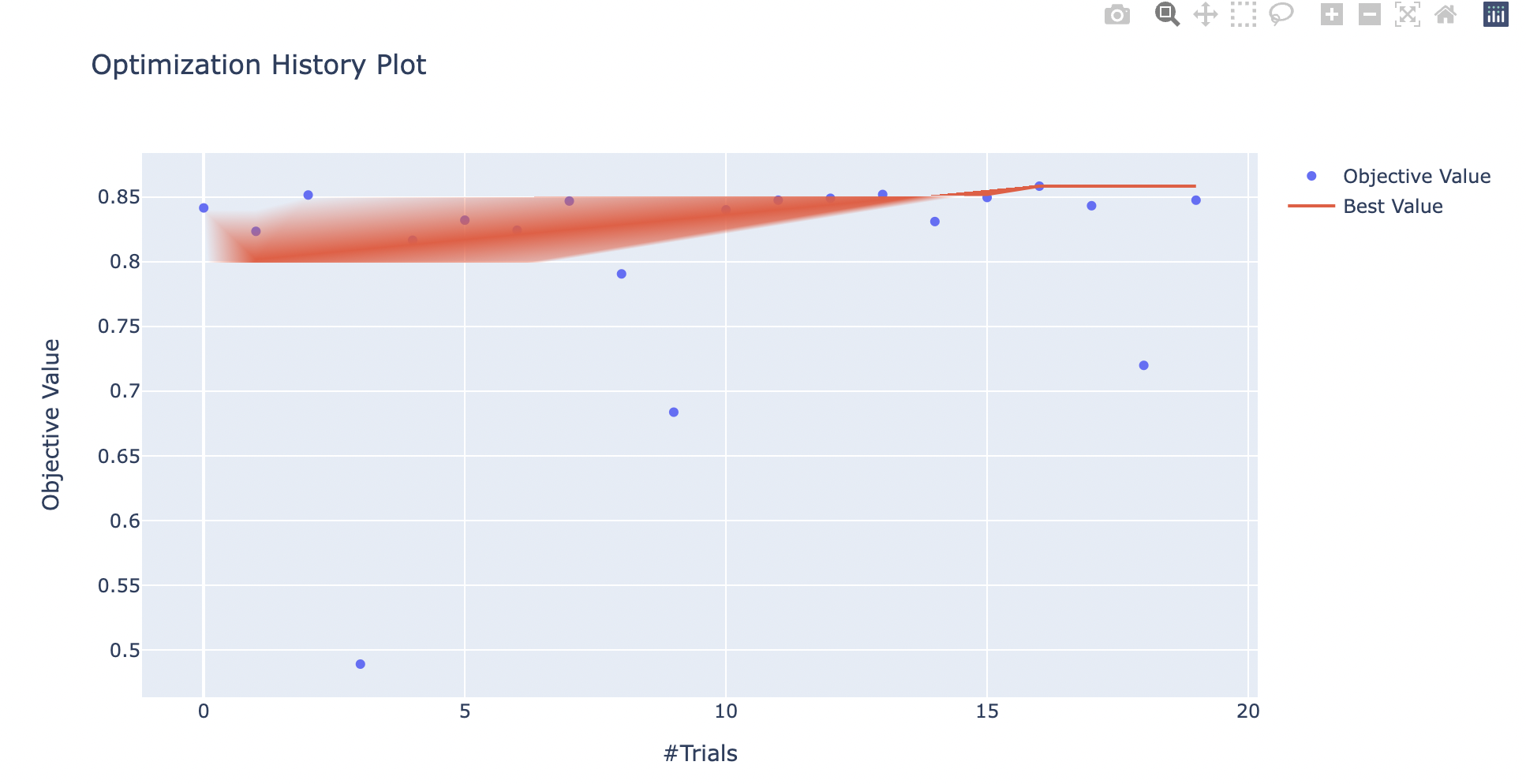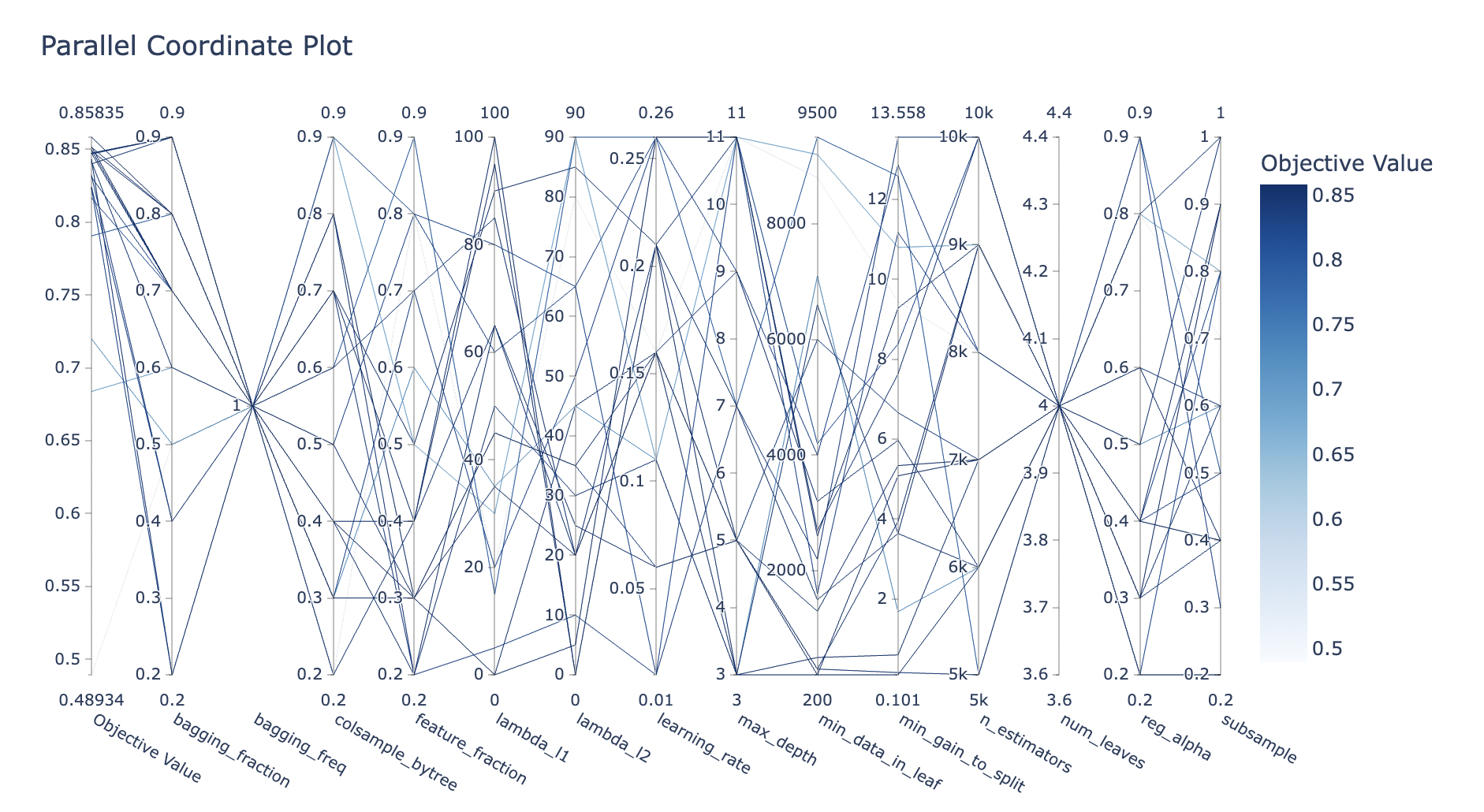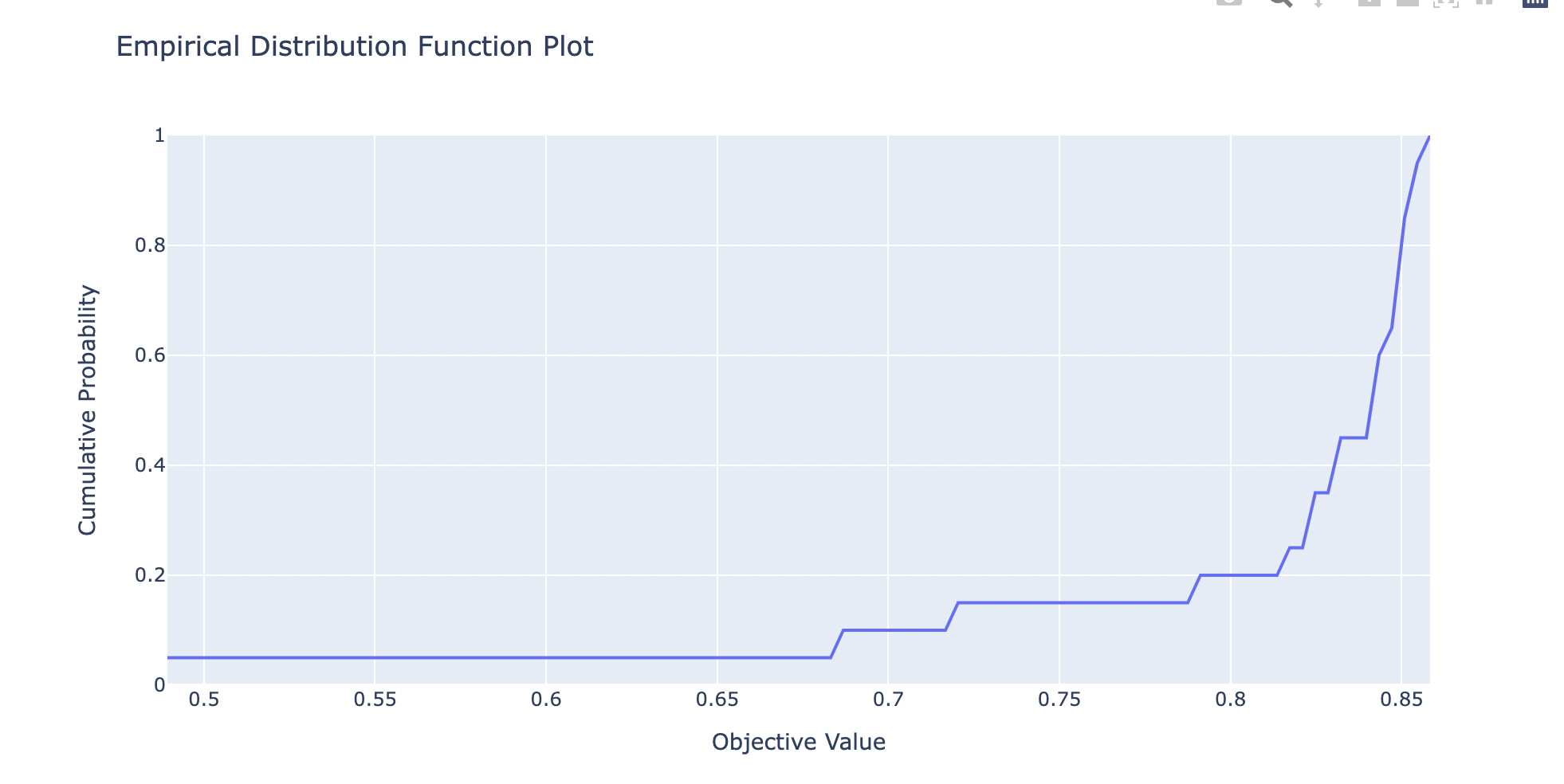使用OPTUNA对LightBGM自动调试参数,并进行绘图可视化

1.optuna基本使用
Optuna是一个自动帮助我们调试参数的工具,使用起来十分方便。比sklearn的gridsearchcv好用很多,一是因为optuna相比于sklearn能够快速进行调参,二是因为它可以将调试参数的过程进行可视化。同时可以如果没训练完,下次继续训练。而optuna内部使用贝叶斯调试参数的机制,可以在最短的时间之内,给我们一个较为优秀的结果,甚至可能会得到一个最优的结果。我们可以根据贝叶斯调参给我们确定的参数范围,自行使用gird search再次验证最佳参数,当然这在大部分情况下没必要了。
我们首先先在函数里使用k折交叉验证,这里使用5折交叉验证,对我们的结果进行优化,当然你也可以使用10折交叉验证。
在函数train_model_category当中,我们一共有三个参数,trail,data,y。trail是optuna自带的一个传入参数,我们在调用train_model_category会使用到它。data是我们训练集的数据,y是训练集的label。函数return的变量则是当前k折交叉验证得到的一个auc(accuracy)的值,因此你可以在这里完全自定义你用来评价的指标,可以是auc,mse,也可以是accuracy均可。optuna完全是一个开放的框架。
在我们的字典 param_grid当中,传入了lightbgm常用的参数,
其中,例如:
"n_estimators": trial.suggest_int("n_estimators", 5000,10000,step=1000),
这里使用调试了n_estimator的参数,suggest_int表示我们在后面的参数是int型变量。因为有些参数可能是小数,也就是浮点型的数据,这个时候我们就需要考虑使用suggest_float 了。step表示,参数可以从5000-10000之间波动,每一次波动的step为1000.因此我们的n_estimator的参数可能的范围是(5000,6000,7000,8000,9000,10000).
import optuna from optuna.integration import LightGBMPruningCallbackfrom sklearn.model_selection import KFold
def train_model_category(trial,data_,y_):
#使用sklearn建立fold folds_ = KFold(n_splits=5, shuffle=True, random_state=546789) param_grid = { "n_estimators": trial.suggest_int("n_estimators", 5000,10000,step=1000), "learning_rate": trial.suggest_float("learning_rate", 0.01, 0.3,step=0.05), "num_leaves": trial.suggest_int("num_leaves", 2**2, 2**5, step=4), "max_depth": trial.suggest_int("max_depth", 3, 12,step=2), "min_data_in_leaf": trial.suggest_int("min_data_in_leaf", 200, 10000, step=100), "lambda_l1": trial.suggest_int("lambda_l1", 0, 100, step=5), "lambda_l2": trial.suggest_int("lambda_l2", 0, 100, step=5), "min_gain_to_split": trial.suggest_float("min_gain_to_split", 0, 15), "bagging_fraction": trial.suggest_float("bagging_fraction", 0.2, 0.95, step=0.1), "bagging_freq": trial.suggest_categorical("bagging_freq", [1]), "feature_fraction": trial.suggest_float("feature_fraction", 0.2, 0.95, step=0.1), "colsample_bytree":trial.suggest_float("colsample_bytree", 0.2, 0.9, step=0.1), "subsample":trial.suggest_float("subsample", 0.2, 1, step=0.1), "reg_alpha":trial.suggest_float("reg_alpha", 0.2, 1, step=0.1), "random_state": 2021, } oof_preds = np.zeros(data_.shape[0]) sub_preds = np.zeros(test_.shape[0]) feature_importance_df = pd.DataFrame()
#这里去除无关的特征,load id,user id,is default feats = [f for f in data_.columns if f not in ['loan_id', 'user_id', 'isDefault'] ] for n_fold, (trn_idx, val_idx) in enumerate(folds_.split(data_)): trn_x, trn_y = data_[feats].iloc[trn_idx], y_.iloc[trn_idx] val_x, val_y = data_[feats].iloc[val_idx], y_.iloc[val_idx] clf = LGBMClassifier(**param_grid) clf.fit(trn_x, trn_y, eval_set= [(trn_x, trn_y), (val_x, val_y)], eval_metric='auc', verbose=100, early_stopping_rounds=40 #30 ) oof_preds[val_idx] = clf.predict_proba(val_x, num_iteration=clf.best_iteration_)[:, 1]
del clf, trn_x, trn_y, val_x, val_y gc.collect() print('Full AUC score %.6f' % roc_auc_score(y, oof_preds)) return roc_auc_score(y, oof_preds)
然后定义优化函数:
study = optuna.create_study(direction="maximize", study_name="LGBM Classifier") func = lambda trial: train_model_category(trial,train, y) study.optimize(func, n_trials=20)
这里传入的参数trial,train和y。同时自定义direction=“maximize”,如果是mse,则可以定义为“minimize”。
现在运行代码,就可以调试参数啦!
2.optuna超参数空间可视化
首先导入相关的包:
from optuna.visualization import plot_contour from optuna.visualization import plot_edf from optuna.visualization import plot_intermediate_values from optuna.visualization import plot_optimization_history from optuna.visualization import plot_parallel_coordinate from optuna.visualization import plot_param_importances from optuna.visualization import plot_slice
绘制参数优化的历史图像:
plot_optimization_history(study)

绘制参数之间高纬度关系:
#绘制高纬关系 plot_parallel_coordinate(study)

绘制经验分布函数:
#绘制经验分布函数 plot_edf(study)

这就是今天的optuna绘制教程啦!觉得有收获的别忘记点下方的赞和推荐呀!


